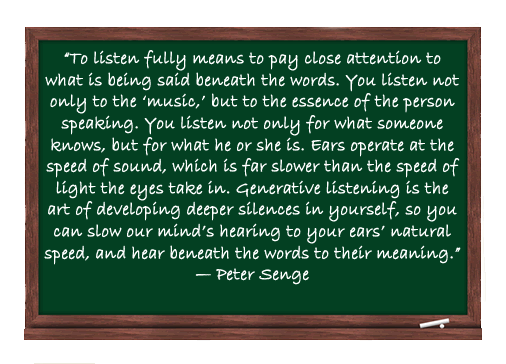Active Listening Activities
Practicing the active listening activities on this page will lead you to improve your communication skills and connect with others in unexpected ways.
Active Listening skills call for quieting the mind and engaging fully in what is going on around you.

The following active listening activities are ordered by the level of skill required, so start from the top and work your way down the list. Spend more time on the level that challenges you until you can master it. If you feel you get stuck and can’t advance to the next level, then take a step back to make sure you have mastered the previous levels of listening skills.
Activity 1
Find a place where you can be alone. Start listening to all the sounds around you, identify them one after another. Humming sounds, noises, traffic and any other sounds that come your way.
When you notice how your thoughts may start drifting away from the sounds, shift your attention back to the sounds. Keep doing this until you can stay focused on sounds for a minute or longer.
Activity 2
Find a place where you’re surrounded by people. Listen to their voices, try making sense of what they’re saying. Shift your attention from one group of people to the next, always trying to make sense of what they’re saying.
The point of this activity is to exert control on how you focus and shift your attention at will.
Activity 3
Still surrounded by people, focus on each person’s mood. No need to focus on their voices, just focus on the person’s demeanor and try to figure out what mood they are in.
The point of this activity is to be able to control how you focus
any and all of your senses, which in turn sharpens your ability to listen.
Activity 4
Let’s start bringing all of the listening skills together.
The next meeting you attend, try the following: Focus on what each person says, without
rehearsing what you’re going to say next.
Focus on each person’s mood and demeanor. You can try paraphrasing or reflecting what people say - if appropriate.
Activity 5
This is the most complex of the active listening activities, because you’ll listen while talking. Well, not exactly, you first listen, then talk, then listen, then talk. You switch back and forth between talking and listening.
The next time you give a presentation to a small group of people, focus your attention on (1) the message you’re giving and (2) each person in the audience: their mood, their words, their facial expressions, and their nonverbal behavior.
You may be tempted to focus on the message only, or on yourself and how you’re delivering the message. Instead, try focusing on the message and each person in the audience.
Being able to both talk and listen is the mark of a master communicator. This ability will give you access to understanding people and connecting with them in very powerful ways.





